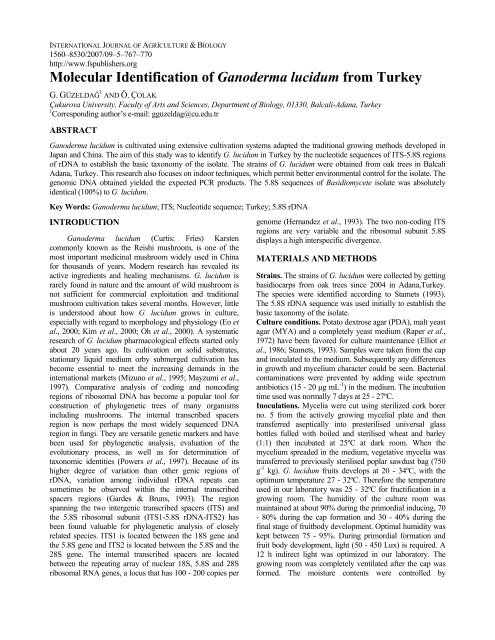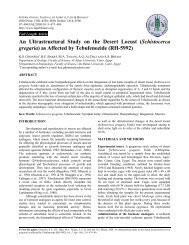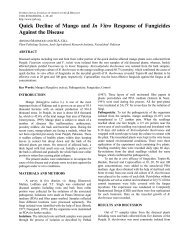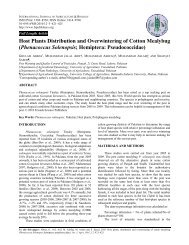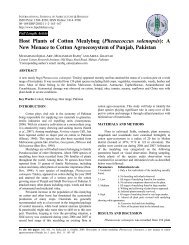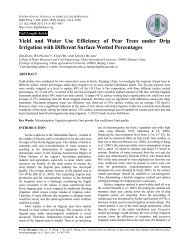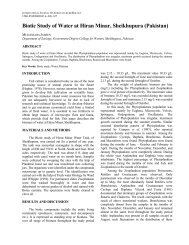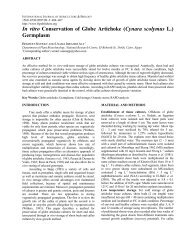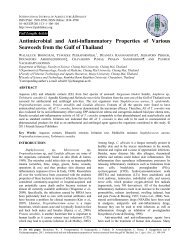Molecular Identification of Ganoderma lucidum ... - Fspublishers.org
Molecular Identification of Ganoderma lucidum ... - Fspublishers.org
Molecular Identification of Ganoderma lucidum ... - Fspublishers.org
Create successful ePaper yourself
Turn your PDF publications into a flip-book with our unique Google optimized e-Paper software.
INTERNATİONAL JOURNAL OF AGRİCULTURE & BİOLOGY<br />
1560–8530/2007/09–5–767–770<br />
http://www.fspublishers.<strong>org</strong><br />
<strong>Molecular</strong> <strong>Identification</strong> <strong>of</strong> <strong>Ganoderma</strong> <strong>lucidum</strong> from Turkey<br />
G. GÜZELDAĞ 1 AND Ö. ÇOLAK<br />
Çukurova University, Faculty <strong>of</strong> Arts and Sciences, Department <strong>of</strong> Biology, 01330, Balcali-Adana, Turkey<br />
1 Corresponding author’s e-mail: gguzeldag@cu.edu.tr<br />
ABSTRACT<br />
<strong>Ganoderma</strong> <strong>lucidum</strong> is cultivated using extensive cultivation systems adapted the traditional growing methods developed in<br />
Japan and China. The aim <strong>of</strong> this study was to identify G. <strong>lucidum</strong> in Turkey by the nucleotide sequences <strong>of</strong> ITS-5.8S regions<br />
<strong>of</strong> rDNA to establish the basic taxonomy <strong>of</strong> the isolate. The strains <strong>of</strong> G. <strong>lucidum</strong> were obtained from oak trees in Balcali<br />
Adana, Turkey. This research also focuses on indoor techniques, which permit better environmental control for the isolate. The<br />
genomic DNA obtained yielded the expected PCR products. The 5.8S sequences <strong>of</strong> Basidiomycete isolate was absolutely<br />
identical (100%) to G. <strong>lucidum</strong>.<br />
Key Words: <strong>Ganoderma</strong> <strong>lucidum</strong>; ITS; Nucleotide sequence; Turkey; 5.8S rDNA<br />
INTRODUCTION<br />
<strong>Ganoderma</strong> <strong>lucidum</strong> (Curtis: Fries) Karsten<br />
commonly known as the Reishi mushroom, is one <strong>of</strong> the<br />
most important medicinal mushroom widely used in China<br />
for thousands <strong>of</strong> years. Modern research has revealed its<br />
active ingredients and healing mechanisms. G. <strong>lucidum</strong> is<br />
rarely found in nature and the amount <strong>of</strong> wild mushroom is<br />
not sufficient for commercial exploitation and traditional<br />
mushroom cultivation takes several months. However, little<br />
is understood about how G. <strong>lucidum</strong> grows in culture,<br />
especially with regard to morphology and physiology (Eo et<br />
al., 2000; Kim et al., 2000; Oh et al., 2000). A systematic<br />
research <strong>of</strong> G. <strong>lucidum</strong> pharmacological effects started only<br />
about 20 years ago. Its cultivation on solid substrates,<br />
stationary liquid medium orby submerged cultivation has<br />
become essential to meet the increasing demands in the<br />
international markets (Mizuno et al., 1995; Mayzumi et al.,<br />
1997). Comparative analysis <strong>of</strong> coding and noncoding<br />
regions <strong>of</strong> ribosomal DNA has become a popular tool for<br />
construction <strong>of</strong> phylogenetic trees <strong>of</strong> many <strong>org</strong>anisms<br />
including mushrooms. The internal transcribed spacers<br />
region is now perhaps the most widely sequenced DNA<br />
region in fungi. They are versatile genetic markers and have<br />
been used for phylogenetic analysis, evaluation <strong>of</strong> the<br />
evolutionary process, as well as for determination <strong>of</strong><br />
taxonomic identities (Powers et al., 1997). Because <strong>of</strong> its<br />
higher degree <strong>of</strong> variation than other genic regions <strong>of</strong><br />
rDNA, variation among individual rDNA repeats can<br />
sometimes be observed within the internal transcribed<br />
spacers regions (Gardes & Bruns, 1993). The region<br />
spanning the two intergenic transcribed spacers (ITS) and<br />
the 5.8S ribosomal subunit (ITS1-5.8S rDNA-ITS2) has<br />
been found valuable for phylogenetic analysis <strong>of</strong> closely<br />
related species. ITS1 is located between the 18S gene and<br />
the 5.8S gene and ITS2 is located between the 5.8S and the<br />
28S gene. The internal transcribed spacers are located<br />
between the repeating array <strong>of</strong> nuclear 18S, 5.8S and 28S<br />
ribosomal RNA genes, a locus that has 100 - 200 copies per<br />
genome (Hernandez et al., 1993). The two non-coding ITS<br />
regions are very variable and the ribosomal subunit 5.8S<br />
displays a high interspecific divergence.<br />
MATERIALS AND METHODS<br />
Strains. The strains <strong>of</strong> G. <strong>lucidum</strong> were collected by getting<br />
basidiocarps from oak trees since 2004 in Adana,Turkey.<br />
The species were identified according to Stamets (1993).<br />
The 5.8S rDNA sequence was used initially to establish the<br />
basic taxonomy <strong>of</strong> the isolate.<br />
Culture conditions. Potato dextrose agar (PDA), malt yeast<br />
agar (MYA) and a completely yeast medium (Raper et al.,<br />
1972) have been favored for culture maintenance (Elliot et<br />
al., 1986; Stamets, 1993). Samples were taken from the cap<br />
and inoculated to the medium. Subsequently any differences<br />
in growth and mycelium character could be seen. Bacterial<br />
contaminations were prevented by adding wide spectrum<br />
antibiotics (15 - 20 μg mL -1 ) in the medium. The incubation<br />
time used was normally 7 days at 25 - 27ºC.<br />
Inoculations. Mycelia were cut using sterilized cork borer<br />
no. 5 from the actively growing mycelial plate and then<br />
transferred aseptically into presterilised universal glass<br />
bottles fulled with boiled and sterilised wheat and barley<br />
(1:1) then incubated at 25ºC at dark room. When the<br />
mycelium spreaded in the medium, vegetative mycelia was<br />
transferred to previously sterilised poplar sawdust bag (750<br />
g -1 kg). G. <strong>lucidum</strong> fruits develops at 20 - 34ºC, with the<br />
optimum temperature 27 - 32ºC. Therefore the temperature<br />
used in our laboratory was 25 - 32ºC for fructification in a<br />
growing room. The humidity <strong>of</strong> the culture room was<br />
maintained at about 90% during the primordial inducing, 70<br />
- 80% during the cap formation and 30 - 40% during the<br />
final stage <strong>of</strong> fruitbody development. Optimal humidity was<br />
kept between 75 - 95%. During primordial formation and<br />
fruit body development, light (50 - 450 Lux) is required. A<br />
12 h indirect light was optimized in our laboratory. The<br />
growing room was completely ventilated after the cap was<br />
formed. The moisture contents were controlled by
increasing ventilation frequency when the humidity was<br />
high. In our work we did not measure the CO2 level.<br />
DNA isolation. G. <strong>lucidum</strong> (Turkish isolate) was cultivated<br />
in 500 mL flasks containing 100 mL Potato dextrose broth<br />
at 27°C under continuous agitation (150 rpm) for 5 days.<br />
Hyphal biomasses were harvested by filtration, freeze dried<br />
at -70°C for 2 days and finely ground.<br />
Total DNA was extracted according to the methods<br />
described in Raeder and Broda (1985) with modifications as<br />
described by Moncalvo et al. (1995a). The protocol used<br />
included the following steps: 50 mg <strong>of</strong> biomass was<br />
suspended in 500 μL <strong>of</strong> extraction buffer (200 mm Tris Cl,<br />
pH 8.5, 250 mm NaCl, 25 mm EDTA, 0.5% SDS) and<br />
vortexed. The resulting suspension was extracted with 350<br />
μL <strong>of</strong> ice cold phenol: chlor<strong>of</strong>orm: isoamyl alcohol<br />
(25:24:1) by vortexing for 1 min. followed by centrifugation<br />
at 15000 g for 45 min. in a microcentrifuge. The upper<br />
phase was transferred to a fresh 1.5 mL tube containing 1<br />
mg/mL final concentration <strong>of</strong> RNAse and incubated at 37°C<br />
for 10 min. 350 μL <strong>of</strong> phenol: chlor<strong>of</strong>orm: isoamyl alcohol<br />
(25: 24:1) was added to this solution, mixed thoroughly and<br />
spun at 15000 g for 10 min. Genomic DNA was<br />
precipitaded from the supernatant by adding 250 μL <strong>of</strong> cold<br />
isopropanol. The nucleic acid pellet was washed using 70%<br />
ethanol, air dried and resuspended in 50 μL <strong>of</strong> TE buffer (10<br />
mm Tris Cl, pH 8.0 & 1 mm EDTA).<br />
PCR amplification. The 5.8S and ITS reqions were<br />
amplified using primers BMB-CR (5´-<br />
GTACACACCGCCCGTCG-3´) and LR1 (5´-<br />
GGTTGGTTTCTTTTCCT-3´) described by White et al.<br />
(1990). Amplification was carried out in a 25 μL reaction<br />
mix containing 1 × PCR Master M (Promega, USA), 1 μm<br />
BMB-CR primer, 1 μm LR1 primer and 200 ng fungal<br />
genomic DNA templates. Amplification was performed in<br />
Mastercycler gradient with the following PCR reqimen:<br />
initial denaturation step at 94°C, 45 seconds annealing at<br />
50°C 1 min elongation at 72°C and a final elongation <strong>of</strong> 10<br />
min 72°C. 2 μL <strong>of</strong> PCR products were electrophoresed in a<br />
0.8% agarose gel using the QIA quick PCR purification kit<br />
(QIAGEN, UK) according to the manufacturer’s protocol.<br />
DNA sequencing. Purified PCR products were sequenced<br />
using the automated DNA sequencer ABI-3100 at the<br />
Advanced Biotechnology Centre (ABC), Imperial College<br />
School <strong>of</strong> Medicine, London, UK. Each reaction was carried<br />
out in a 12 μL volume containing 120 ng DNA and 12.8 pM<br />
sequencing primers. Primers 5.8S (5´-<br />
CGCTGCGTTCTTCATCG-3´), 5.8 SR (5´-<br />
TCGATGAAGAACGCAGC-3´) and ITS5 (5´-<br />
GGAAGTAAAAGTCGTAACAAGG-3´) (White et al.,<br />
1990) were used to sequence ITS1, ITS2 and 5.8S reqions,<br />
respectively.<br />
Cluster analysis. The sequences were used as queries to<br />
look similar sequences in databases <strong>of</strong> DNA (GenBank,<br />
EMBL) using Basic Local Alignment Search Tool<br />
(BLAST) (Altschul et al., 1990).<br />
GÜZELDAĞ AND ÇOLAK / Int. J. Agri. Biol., Vol. 9, No. 5, 2007<br />
768<br />
RESULTS AND DISCUSSION<br />
DNA extraction and PCR amplification. The genomic<br />
DNA obtained was <strong>of</strong> very good quality and yielded the<br />
expected PCR products using suitable primers. The PCR<br />
products size varied between 800 - 850 bp and the yield<br />
ranged 1765.8 μg mL -1 (Fig. 1 & 2).<br />
Cluster analysis. ITS region sequences, 5.8 sequences<br />
analysis: Since the studied isolate was considered to be<br />
<strong>Ganoderma</strong>, its classification was only based on the<br />
multiple nucleotide alignments <strong>of</strong> the ITS 1 and ITS 2<br />
reqion sequences as described by Moncalvo et al. (1995b).<br />
The 5.8S rDNA gene located between the ITS 1 and 2<br />
reqions was, as expected very well conversed (158 bp in<br />
lenght). The 5.8 sequences <strong>of</strong> Basidiomycete isolate was<br />
absolutely identical (Moncalvo et al., 1995c).<br />
The search for similar sequences in the GenBank<br />
using the BLAST program showed that Basidiomycete<br />
isolate belonged to the Eukaryota; Fungi; Basidiomycota;<br />
Hymenomycetes; Homobasidiomycetes; Aphyllophorales;<br />
<strong>Ganoderma</strong>taceae; <strong>Ganoderma</strong> <strong>lucidum</strong> (GenBank accesion<br />
number bankit674033 AY870653). To facilitate analysis by<br />
database users we have substituted the complementary<br />
strand <strong>of</strong> our submitted sequence below containing 5.8S<br />
ribosomal DNA and internal transcribed spacer 2 on the<br />
reverse complemented strand (minus strand) and coding<br />
strand (plus strand).<br />
01 GTGCCTGTGC CTGCGTTTAT<br />
CACAAACTCT ATAAAGTATT AGAATGTGTA<br />
TTGCGATGTA 61 ACGCATCTAT ATACAACTTT<br />
CAGCAACGGA TCTCTTGGCT CTCGCATCGA<br />
TGAAGAACGC 121 AGCGAAATGC GATAAGTAAT<br />
GTGAATTGCA GAATTCAGTG AATCATCGAA<br />
TCTTTGAACG 181 CACCTTGCGC TCCTTGGTAT<br />
TCCGAGGAGC ATGCCTGTTT GAGTGTCATG<br />
AAATCTTCAA 241 CTTACAGACC TTTGCGGGTT<br />
TGTAGGCTTG GACTTTGGAG GCTTGTCGGC<br />
CGTGTTTTGG 301 TCGGCTCCTC TTAAATGTAT<br />
TAGCTTGATT CCTTGCGGAT CGGCTCTCGG<br />
TGTGATAATG 361 TCTACGCCGC GACCGTGAAG<br />
CGTTTTGGCG AGCTTCTAAC CGTCTCGTTT<br />
TGTGAAGACA 421 GCCTTTTTAT GAACCTCTGA.<br />
Researchers can improve the techniques for growing<br />
mushrooms. Therefore the importance <strong>of</strong> physiological<br />
stress takes place for affecting the initiation <strong>of</strong> fruit bodies<br />
(Oei, 1991). In our study no fungal or bacterial<br />
contaminants were found in the glass bottles or sawdust<br />
bags, but in later studies, we noticed that during the fruiting<br />
stage after the appearance <strong>of</strong> primordia nearly all the fruit<br />
bodies had unformed shapes (Fig. 3). We corrected the<br />
problem by keeping the temperature between 25 - 32ºC and<br />
avoiding the direct light, because when the light level was<br />
higher than 450 lux the stipe was getting shorter and the cap<br />
was forming earlier. In other word, the stipe was getting<br />
elongated and the pileus formation was getting delayed at<br />
low light intensities. We controlled this problem by using
IDENTİFİCATİON OF G. LUCİDUM / Int. J. Agri. Biol., Vol. 9, No. 5, 2007<br />
Fig. 1. Agarose gel electrophoresis <strong>of</strong> DNA extracted<br />
from G. <strong>lucidum</strong>.<br />
The DNAs extracted were dissolved in 50 µl <strong>of</strong> TE buffer and the 10 µl <strong>of</strong><br />
the DNA solution was electrophoresed on an agarose gel (0.9 %). Lanes:<br />
M, DNA 1kb ladder: 1, G. <strong>lucidum</strong> isolate<br />
M 1<br />
Fig. 2. PCR amplification <strong>of</strong> DNA extracted from G.<br />
Lucidum<br />
Primers BMB-CR (5´GTACACACCGCCCGTCG-3´) and LR1 (5´-<br />
GGTTGGTTTCTTTTCCT-3´) were used. Lanes: M, DNA 1kb ladder: 1,<br />
G. <strong>lucidum</strong> isolate<br />
M 1<br />
indirect light and by this way we had healty formed G.<br />
<strong>lucidum</strong> (Fig. 4). The data presented here showed that ITS<br />
based clades and 5.8S rDNA are consistent with<br />
<strong>Ganoderma</strong> <strong>lucidum</strong>. Species boundaries within ITS clades<br />
still need to be addressed with mating studies (Moncalvo et<br />
al., 1995a). For classification, type specimens must be<br />
studied, where available before naming ITS clades<br />
769<br />
Fig. 3. Unformed fruitbodies <strong>of</strong> G. Lucidum<br />
Fig. 4. Mature G. Lucidum<br />
(Moncalvo et al., 1995a). By using traditional methods, the<br />
ease and reducing cost <strong>of</strong> PCR amplification and direct<br />
sequencing techniques and the rapid expansion <strong>of</strong> molecular<br />
databases for a broad array <strong>of</strong> fungi molecular methods<br />
might become the easiest way to identify G. <strong>lucidum</strong>. There<br />
is currently research interest into the pharmacological and<br />
commercial production <strong>of</strong> <strong>Ganoderma</strong> in Turkey. This<br />
research is the first report to certify the new Turkish isolate<br />
<strong>of</strong> <strong>Ganoderma</strong> <strong>lucidum</strong>. We believe that in the future,<br />
research on G. <strong>lucidum</strong>’s miraculous properties will be<br />
extended use because <strong>of</strong> its abundance due to the success <strong>of</strong><br />
cultivation and the common understanding that this strain<br />
contains vast number <strong>of</strong> medicinal substances and the<br />
combination <strong>of</strong> these elements that make it so potent in the<br />
curing diseases.<br />
REFERENCES<br />
Altschul, S.F., W. Gish, W. Miller, E.W. Myers and D.J. Lipman, 1990.<br />
Basic local alignment search tool. J. Mol. Biol., 215: 403–10<br />
Eo, S.K., Y.S. Kim, C.K. Lee and S.S. Han, 2000. Possible mode <strong>of</strong><br />
antiviral activity <strong>of</strong> acidic protein bound polysaccharide isolated<br />
from <strong>Ganoderma</strong> <strong>lucidum</strong> on herpes simplex viruses. J.<br />
Ethnopharmacol., 72: 475–81<br />
Gardes, M. and T.D. Bruns, 1993. ITS primers with enhanced specificity for<br />
basidiomycetes- application to the identification <strong>of</strong> mycorrhizae and<br />
rusts. Mol. Ecol., 2: 113–8
Hernandez, R., S. Martinez-Calvillo, R. Hernandez-Rivas and E. Gomez,<br />
1993. Trypanosoma cruzi ribosomal RNA genes: a review. Biol.<br />
Res., 26, 109–14<br />
Kim, Y.S., S.K. Eo, K.W. Oh, C.K. Lee and S.S. Han, 2000. Antiherpetic<br />
activities <strong>of</strong> acidic protein bound polysacchride isolated from<br />
<strong>Ganoderma</strong> <strong>lucidum</strong> alone and in combinations with interferons. J.<br />
Ethnopharmacol., 72: 451–8<br />
Mayzumi, F., H. Okamoto and T. Mizuno, 1997. Cultivation <strong>of</strong> Reishi<br />
(<strong>Ganoderma</strong> <strong>lucidum</strong>). Food Rev. Int., 13: 365–82<br />
Mizuno, T., G.Y. Wang, J. Zhang, H. Kawagishi, T. Nishitoba and J.X. Li,<br />
1995. Reishi, <strong>Ganoderma</strong> <strong>lucidum</strong> and <strong>Ganoderma</strong> tsugae: bioactive<br />
substances and medicinal effects. Food Rev. Int., 11: 151–66<br />
Moncalvo, J.M., H. Wang and R.S. Hseu, 1995a. Gene phylogeny <strong>of</strong> the<br />
<strong>Ganoderma</strong> <strong>lucidum</strong> complex based on ribosomal DNA sequences.<br />
Comparison with traditional taxonomic characters. Mycol. Res., 99:<br />
1489–99<br />
Moncalvo, J.M., H. Wang and R.S. Hseu, 1995b. Phylogenetic relationships<br />
in <strong>Ganoderma</strong> inferred from the internal transcribed spacers and 25S<br />
ribosomal DNA sequences. Mycologia, 87: 223–38<br />
Moncalvo, J.M., H. Wang and R.S. Hseu, 1995c. The use <strong>of</strong> ribosomal<br />
DNA sequence data for species identification and phylogeny in the<br />
<strong>Ganoderma</strong>taceae. In: Buchanan, P.K., R.S. Hseu and J.M.<br />
Moncalvo (eds.), <strong>Ganoderma</strong>: Systematics, Phytopathology and<br />
Pharmacology: Proceedings <strong>of</strong> Contributed Symposium 59AB 5 th<br />
International Mycological Congress, Vancouver, August 14 ± 21,<br />
1994. 31 ± 44. National Taiwan University, Taipei<br />
GÜZELDAĞ AND ÇOLAK / Int. J. Agri. Biol., Vol. 9, No. 5, 2007<br />
770<br />
Oei, P., 1991. Manual on Mushroom Cultivation: Techniques, Species and<br />
Opportunities for Commercial Application in Developing Countries.<br />
Tool Publication, Amsterdam, The Netherlands<br />
Oh, K.W., C.K. Lee, Y.S. Kim, S.K. Eo and S.S. Han, 2000. Antiherpetic<br />
activities <strong>of</strong> acidic protein bound polysacchride isolated from<br />
<strong>Ganoderma</strong> <strong>lucidum</strong> alone and in combinations with acyclovir and<br />
vidarabine. J. Ethnopharmacol., 72: 221–7<br />
Powers, T.O., T.C. Todd, A.M. Burnell, P.C.B. Murray, C.C. Fleming, A.L.<br />
Szalanki, B.A. Adams and T.S. Harris, 1997. The internal<br />
transcribed spacer region as a taxonomic marker for nematodes. J.<br />
Nematol., 29, 441–50<br />
Raeder, U. and P. Broda, 1985. Rapid preparation <strong>of</strong> DNA from<br />
filamentous fungi. Lett. Appl. Microbiol., 1: 17–20<br />
Raper, C.A., J.R. Raper and R.E. Miller, 1972. Genetic analysis <strong>of</strong> the lifecycle<br />
<strong>of</strong> Agaricus bisporus. Mycologia, 64: 1088–117<br />
Stamets, P., 1993. Growing Gourmet and Medicinal Mushrooms. Ten<br />
Speed Press, Berkeley, C.A<br />
White, T.J., T. Bruns, S. Lee and J. Taylor, 1990. Amplification and direct<br />
sequencing <strong>of</strong> fungal ribosomal RNA genes for phylogenetics. In:<br />
Innis, M.A., D.H. Gelfand, J.J. Shinsky, T.J. White (eds.), PCR<br />
Protocols: A Guide to Methods and Applications, pp: 315–22.<br />
Academic Press, San Diego<br />
(Received 13 February 2007; Accepted 09 March 2007)


